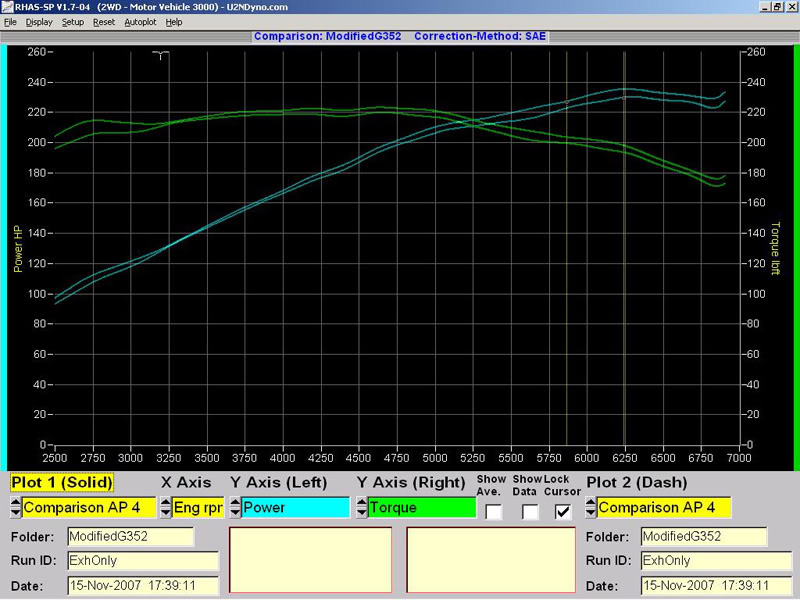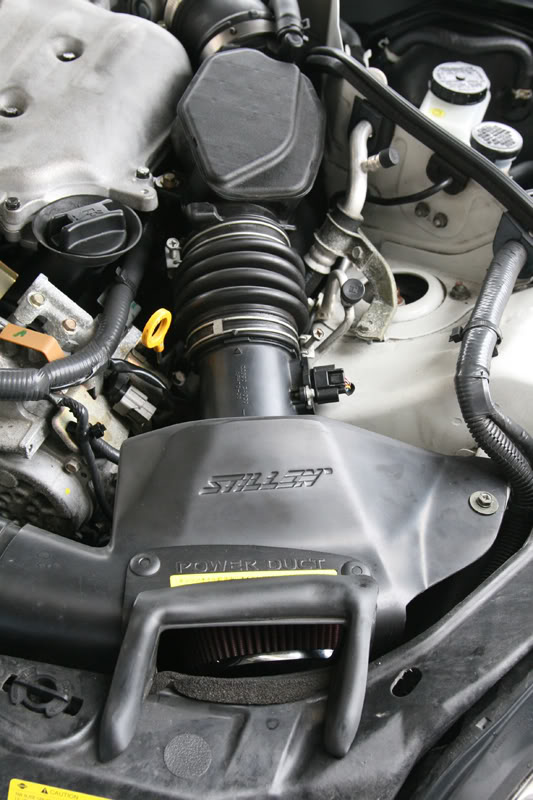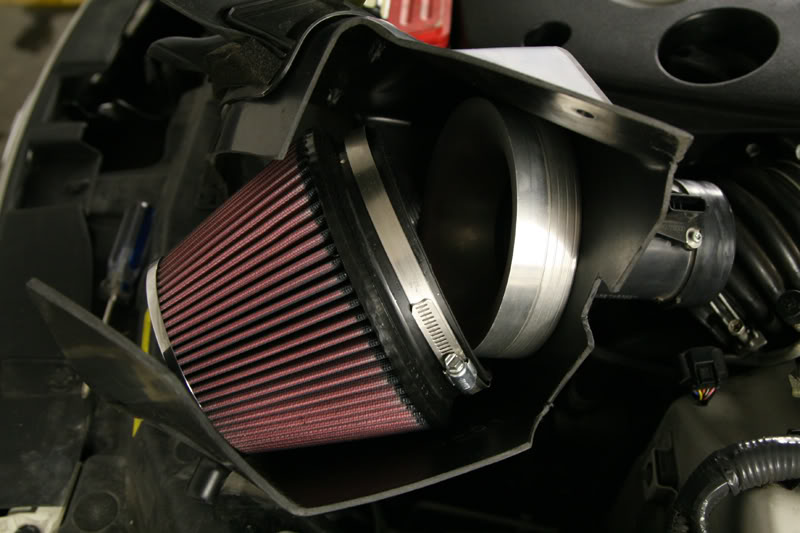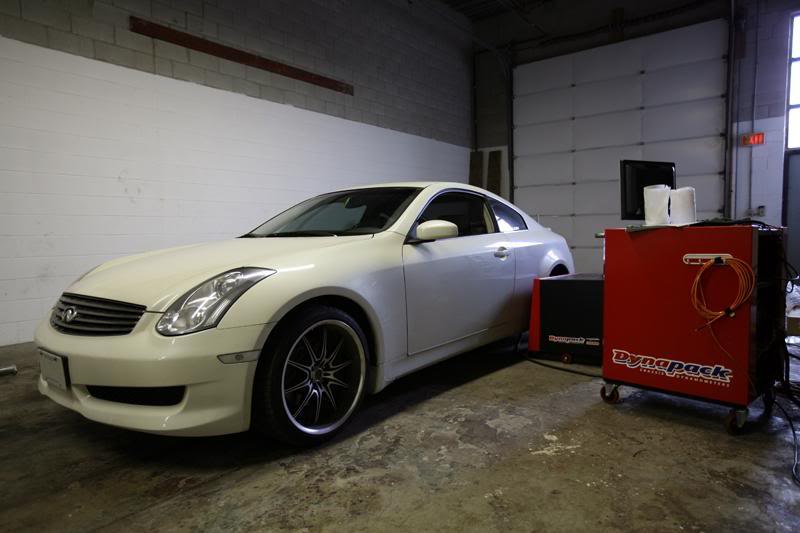Stillen intake dyno test
#1
Stillen intake dyno test
After installing and testing a Stillen exhaust on my '06 6MT coupe, we installed a Stillen intake. Here's the results, as tested on U2Ndyno.com's Dynapack.
This graph shows the baseline achieved with the Stillen exhaust vs the intake and exhaust combo.

As you can see, we saw consistent power gains from 3250rpm all the way to redline. We also saw quite a large jump in torque at just 2650rpm, where there was a 10wtq gain compared to the best run with just the exhaust installed (although this may have been the result of the way the Dynapack loads up at the start of a run). The biggest horsepower gain was seen at 5650rpm, right in the sweet spot of the powerband, with a 6.5whp jump over the exhaust-only graph. As for peak gains, maximum wheel horsepower jumped to 235.3whp at 6250rpm compared to 230.14whp at 6300rpm with just the exhaust, while maximum torque increased from 219.76 @ 4650rpm with the exhaust to 223.1 @ 4635rpm with the hi-flow intake added to the equation. Given that this kit really only replaces the stock intake box and filter, these gains were impressive and inexpensive not to mention very easy to install. Literally about a 15-minute job to install it.
Here's a few pics of the intake on the car. I particularly liked the way the velocity stack bolts between the filter housing and the MAF housing. Clever piece of engineering.



This graph shows the baseline achieved with the Stillen exhaust vs the intake and exhaust combo.

As you can see, we saw consistent power gains from 3250rpm all the way to redline. We also saw quite a large jump in torque at just 2650rpm, where there was a 10wtq gain compared to the best run with just the exhaust installed (although this may have been the result of the way the Dynapack loads up at the start of a run). The biggest horsepower gain was seen at 5650rpm, right in the sweet spot of the powerband, with a 6.5whp jump over the exhaust-only graph. As for peak gains, maximum wheel horsepower jumped to 235.3whp at 6250rpm compared to 230.14whp at 6300rpm with just the exhaust, while maximum torque increased from 219.76 @ 4650rpm with the exhaust to 223.1 @ 4635rpm with the hi-flow intake added to the equation. Given that this kit really only replaces the stock intake box and filter, these gains were impressive and inexpensive not to mention very easy to install. Literally about a 15-minute job to install it.
Here's a few pics of the intake on the car. I particularly liked the way the velocity stack bolts between the filter housing and the MAF housing. Clever piece of engineering.



Last edited by Modified Dave; 02-16-2008 at 02:30 PM.
The following users liked this post:
Zer0_KooL (03-22-2017)
#4
Correct me if I'm wrong (since I've never tested one), but I thought the Z-tube was mostly a sound and appearance mod? I know the Z-tube does make for a more aggressive intake growl and it may also serve to smooth airflow which could help with high rpm power, but I think most guys are doing it more for the sound and the looks. I'm definitely thinking about doing a carbon Z-tube mostly because I think it'll add some style under the hood.
Next power mods to come are headers, high-flow cats, ECU reflash to fix the throttle-by-wire issues and a Haltech Platinum to fine-tune fuel, ignition, and cam timing maps. Plus we're going to try another set of Pulstar plugs since those picked up so much power on Sasha's 350Z Roadster (10whp).
Next power mods to come are headers, high-flow cats, ECU reflash to fix the throttle-by-wire issues and a Haltech Platinum to fine-tune fuel, ignition, and cam timing maps. Plus we're going to try another set of Pulstar plugs since those picked up so much power on Sasha's 350Z Roadster (10whp).
Last edited by Modified Dave; 08-12-2008 at 01:20 PM.
#5
I didn't see any consistent gains from my stillen airbox (untuned- car was stock with the exception of the intake).
Thanks for the data though. Interesting shift in the power-curve. Makes me wonder if there was other factors involved, as dyno's can be manipulated very easily (not necessarily intentionally).
.
Thanks for the data though. Interesting shift in the power-curve. Makes me wonder if there was other factors involved, as dyno's can be manipulated very easily (not necessarily intentionally).
.
#6
We did the exhaust on my G before the intake. I wonder if the improved flow on the exhaust side helped the intake show better on my G than it did on yours?
Lots of other possible variables too, of course, including the dyno issue you've raised, as well as the type of gas in our tanks (I run on 94 octane, which we can get at the pump up here from Sunoco), the condition of our spark plugs, the temps of our engines during the test, the condition of the oil during our tests, etc, etc.
Generally speaking I try to control for as many of these variables as possible by making sure we run the engine at consistent temps, fresh oil, fresh or at least low mileage plugs, full tank of 94 octane, and on a low mileage and well cared for Dynapack hub dyno which is definitely one of the most consistent dynos I've ever tried (and I've tried them all...a lot! haha).
In my experience, you can't beat a Dynapack for repeatable and consistent results. For example, when we tested those Pulstar plugs on Sasha's Z Roadster he had previously done over 40 pulls with a maximum run of 239.9whp. Weeks later we bolted the dyno up to it and baselined it prior to testing the plugs at 239.7whp within three pulls and then started to see some drop-off as engine temp creeped up. That's pretty darn consistent.
I think the velocity stack Stillen uses on their intake is really the key to the power gains we saw on my G. Velocity stacks are well understood to improve the quality of airflow, so it is a bit surprising to me to learn that you saw no gains from your intake. Makes me wonder if something was holding it back.
Lots of other possible variables too, of course, including the dyno issue you've raised, as well as the type of gas in our tanks (I run on 94 octane, which we can get at the pump up here from Sunoco), the condition of our spark plugs, the temps of our engines during the test, the condition of the oil during our tests, etc, etc.
Generally speaking I try to control for as many of these variables as possible by making sure we run the engine at consistent temps, fresh oil, fresh or at least low mileage plugs, full tank of 94 octane, and on a low mileage and well cared for Dynapack hub dyno which is definitely one of the most consistent dynos I've ever tried (and I've tried them all...a lot! haha).
In my experience, you can't beat a Dynapack for repeatable and consistent results. For example, when we tested those Pulstar plugs on Sasha's Z Roadster he had previously done over 40 pulls with a maximum run of 239.9whp. Weeks later we bolted the dyno up to it and baselined it prior to testing the plugs at 239.7whp within three pulls and then started to see some drop-off as engine temp creeped up. That's pretty darn consistent.
I think the velocity stack Stillen uses on their intake is really the key to the power gains we saw on my G. Velocity stacks are well understood to improve the quality of airflow, so it is a bit surprising to me to learn that you saw no gains from your intake. Makes me wonder if something was holding it back.
#7
Trending Topics
#8
I love it when people do before and after testing like this. Now my question is which before and after dyno was used for the comparison because from what I've seen with VQ35s, they tend to gain power on every successive dyno run. When it comes to these intakes, I don't doubt they gain a couple HP here and there across portions of the curve, but we have to keep in mind that the hood is up during the test. The Stillen CAI is not completely sealed from engine heat and that can impact performance below 35mph or if you're waiting in the stagging lanes. Additionally, two of our most avid drag racers on the forum have tested with and without the Stillen CAIs and the results (both ET and MPH) favor the stock intake. This is under similiar conditions, the same tracks, and similiar 60 foots. IMO, this data shows that the Stillen CAI either makes the car fractionally slower or it makes no difference in performance.
#9
DaveB, all dyno runs were done on the U2Ndyno.com Dynapack hub dyno, which is one of the most consistent and reliable dynos on the market today. For both the baseline and with the intake install, we did enough pulls such that we stopped seeing gains and in fact started to see power loss due to heat soak. We used the best run before and after as our point of comparison, though if you averaged out all the before and after runs net gains are basically identical to the gains seen on the best before/after runs.
Obviously a dyno is not the real world. We do not have the same airflow characteristics when a car's on a dyno compared to when it's rolling down the road, and this can both help or hurt power gains depending on the kind of modification being tested. With intakes it tends to hurt them more than it helps them.
Nevetheless, IMO a dyno is a far better way of consistently and fairly measuring performance gain than a drag strip. With any kind of scientific testing the objective is to limit as many of the confounding variables as possible. At the dyno the main confounder is the lack of airflow over the car and to the engine. With a drag strip, you have real world airflow, but you have many other confounding variables that render the results less scientifically valid. The driver is a huge variable, as are track conditions, tire conditions, transmission and clutch conditions, ambient air temp (which dyno software corrects for), etc., etc. A dyno elminates all of these confounders, and is therefore a far better tool for measure performance gain IMO.
Of course the best scenario is to triangulate or cross-reference your data by using multiple test methods, whereby you create a more complete and accurate picture of peformance gain. To "triangulate" your testing, you'd need to have 3 points of data or three testing methods, say the dyno, the drag strip, and a road course where lap times are generated. Believe me, if I could do this kind of testing on a magazine budget, I would! But that's not the reality of my situation, so we opt to use the dyno since it gives us consistent and repeatable power numbers and limits confounders more than a drag strip or road course.
Obviously a dyno is not the real world. We do not have the same airflow characteristics when a car's on a dyno compared to when it's rolling down the road, and this can both help or hurt power gains depending on the kind of modification being tested. With intakes it tends to hurt them more than it helps them.
Nevetheless, IMO a dyno is a far better way of consistently and fairly measuring performance gain than a drag strip. With any kind of scientific testing the objective is to limit as many of the confounding variables as possible. At the dyno the main confounder is the lack of airflow over the car and to the engine. With a drag strip, you have real world airflow, but you have many other confounding variables that render the results less scientifically valid. The driver is a huge variable, as are track conditions, tire conditions, transmission and clutch conditions, ambient air temp (which dyno software corrects for), etc., etc. A dyno elminates all of these confounders, and is therefore a far better tool for measure performance gain IMO.
Of course the best scenario is to triangulate or cross-reference your data by using multiple test methods, whereby you create a more complete and accurate picture of peformance gain. To "triangulate" your testing, you'd need to have 3 points of data or three testing methods, say the dyno, the drag strip, and a road course where lap times are generated. Believe me, if I could do this kind of testing on a magazine budget, I would! But that's not the reality of my situation, so we opt to use the dyno since it gives us consistent and repeatable power numbers and limits confounders more than a drag strip or road course.
Last edited by Modified Dave; 03-22-2008 at 02:41 PM.
#10
All these so called sealed units should be tested with an electronic thermometer to make sure the air entering the filter is actually ambient [outside] and doesn't have some engine compartment leakage.
Remember each 11F hotter air will decrease air density by 1% and drop power output by 1%.................not unusually to see a 33-44F rise losing 4% of possible power.
http://images.google.com/images?hl=e...-8&sa=N&tab=wi
Remember each 11F hotter air will decrease air density by 1% and drop power output by 1%.................not unusually to see a 33-44F rise losing 4% of possible power.
http://images.google.com/images?hl=e...-8&sa=N&tab=wi
Last edited by Q45tech; 03-24-2008 at 03:37 PM.
#14
I recently tested a Pop Charger on my buddy Andrew's non-RevUp '03 G35 Coupe for a website we're working on together and it made pretty decent gains but not quite as much as the Stillen did on my RevUp '06 G Coupe (different engine, different car, so very tough to compare).
http://www.tune2win.com/index.php/dy..._power_adders/
I personally like the Stillen urethane filter housing, which looks very OEM and does an excellent job of protecting the filter from the engine's heat and also integrates the OEM Power Duct.
http://www.tune2win.com/index.php/dy..._power_adders/
I personally like the Stillen urethane filter housing, which looks very OEM and does an excellent job of protecting the filter from the engine's heat and also integrates the OEM Power Duct.
#15
I recently tested a Pop Charger on my buddy Andrew's non-RevUp '03 G35 Coupe for a website we're working on together and it made pretty decent gains but not quite as much as the Stillen did on my RevUp '06 G Coupe (different engine, different car, so very tough to compare).
http://www.tune2win.com/index.php/dy..._power_adders/
I personally like the Stillen urethane filter housing, which looks very OEM and does an excellent job of protecting the filter from the engine's heat and also integrates the OEM Power Duct.
http://www.tune2win.com/index.php/dy..._power_adders/
I personally like the Stillen urethane filter housing, which looks very OEM and does an excellent job of protecting the filter from the engine's heat and also integrates the OEM Power Duct.




